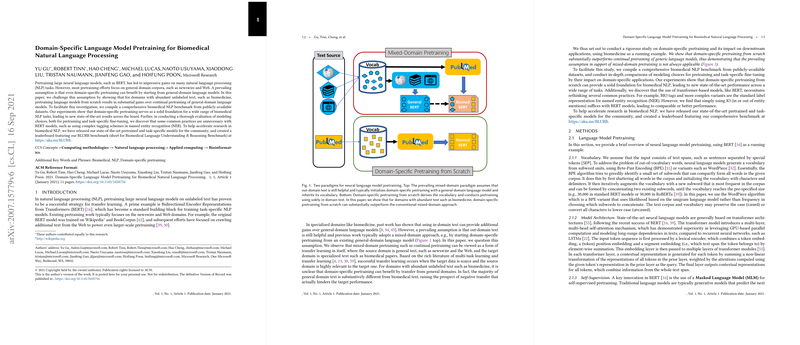Domain-Specific LLM Pretraining for Biomedical Natural Language Processing
The paper "Domain-Specific LLM Pretraining for Biomedical Natural Language Processing" addresses a prevailing assumption in the field of NLP: the benefits of mixed-domain pretraining. The authors argue that domain-specific pretraining from scratch can be more effective, particularly in domains with a vast amount of unlabeled text, such as biomedicine.
Key Insights
The investigation presented in the paper leads to several important findings:
- Superior Performance of Domain-Specific Pretraining: Pretraining LLMs from scratch using domain-specific text (e.g., PubMed abstracts) outperforms the traditional continual pretraining from general-domain models. This contradicts the common assumption that leveraging out-domain text in pretraining is beneficial.
- Impact of In-Domain Vocabulary: The authors demonstrate that using an in-domain vocabulary, derived specifically from the target domain text, contributes significantly to the performance. For instance, biomedical terms are better represented, leading to more effective learning and representation of these terms within the model.
- Effect of Pretraining Corpus: Pretraining exclusively on PubMed abstracts yields better performance over using a mix of abstracts and full-text articles from PubMed Central. Additionally, when using the continuous pretraining on general domain text (such as Wikipedia), there is negligible to no benefit in biomedical tasks, reinforcing the superiority of text from the specific domain.
Experimental Evaluation
The authors compile a comprehensive benchmark named the Biomedical Language Understanding and Reasoning Benchmark (BLURB), featuring datasets across diverse tasks such as named entity recognition (NER), evidence-based medical information extraction (PICO), relation extraction, sentence similarity, document classification, and question answering.
In a detailed comparative paper, they demonstrate:
- PubMedBERT Outperforms Others: Benchmarking results show that PubMedBERT, a domain-specific LLM pretrained from scratch using PubMed abstracts, consistently outperforms other models including BioBERT, SciBERT, and BlueBERT across the majority of BLURB tasks. For instance, PubMedBERT achieves an F1 of 85.62 in BC5-disease, compared to BioBERT’s 84.70.
- Validation of Pretraining Choices: The paper scrutinizes various pretraining approaches and their effectiveness:
- Whole-word masking (WWM) was found to lead to consistent performance improvements across tasks compared to word-piece tokenization.
- PubMedBERT’s ability to outperform even with 50% of the pretraining compute used by its continuous pretraining counterparts further validates the domain-specific pretraining approach.
Implications and Future Directions
Practically, adopting a domain-specific pretraining approach could lead to more efficient and effective deployment of LLMs in specialized fields such as biomedicine. From a theoretical perspective, this work prompts a re-evaluation of the transfer learning assumption that more text is always better, highlighting the need to consider the relevance of the pretraining corpus to the target application.
The findings have significant implications for future developments in AI and NLP:
- Increased Focus on Domain-Specific Pretraining: Encouraging more targeted pretraining efforts to harness the strengths of domain-specific data effectively.
- Expansion of BLURB: Inclusion of additional datasets and tasks within BLURB to cover more subtleties and nuances in biomedical NLP, ensuring comprehensive benchmarking.
- Cross-Domain Comparisons: Exploring the generalizability of these findings to other high-value domains, such as finance and law, enhancing the transfer learning framework.
In conclusion, this paper provides a compelling argument for reevaluating and restructuring pretraining methodologies concerning domain-specific tasks. Their results advocate for a paradigm shift towards domain-specific pretraining, supported by substantial empirical evidence, and contribute significantly to the advancement of NLP applications in specialized domains like biomedicine.
Access the BLURB benchmark and leaderboard for more detailed experimental results and to track ongoing research efforts.
